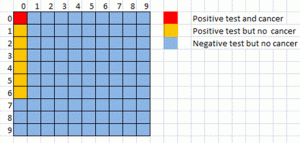Describing risk
From “Decision Science News”, a post on communicating risks to the general public (eg, in newspapers)
They give a list of approaches to use less often (relative risks, single-event probabilities as fractions, conditional probabilities) and approaches to use more often (frequencies with an explicit reference group).
They don’t mention David Spiegelhalters ‘micromorts‘, or the useful `number needed to treat’ for describing screening or treatment probabilities, though the latter is implicit in their examples. The picture above shows a hypothetical situation where you would need to screen 81 100 people, and have six false positive diagnoses, in order to have one true positive diagnosis. In terms of the traditional conditional probabilities that’s a test with 100% accuracy in detecting cases and better than 90% accuracy in detecting non-cases, which sounds much more useful than the situation revealed by the picture.
Thomas Lumley (@tslumley) is Professor of Biostatistics at the University of Auckland. His research interests include semiparametric models, survey sampling, statistical computing, foundations of statistics, and whatever methodological problems his medical collaborators come up with. He also blogs at Biased and Inefficient See all posts by Thomas Lumley »
